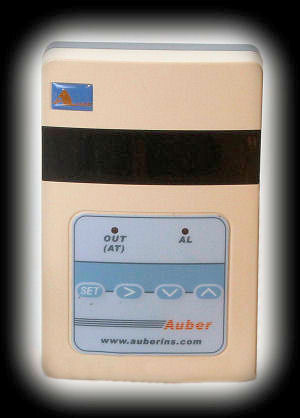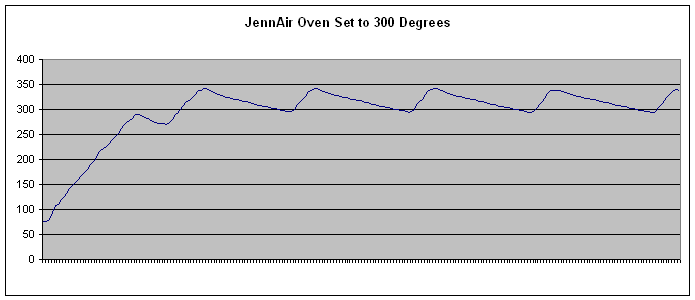 |
 |

Operating The Auber Instruments Controller So, how does the Auber Instruments controller perform in operation? The real test of any temperature controller is how it performs at low temperatures. The reason for this is that the device can only make the cooker hotter. The cooker has to cool off on its own, and a cooker is much more willing to cool off at 450 degrees than it is at 225 degrees. So, the controller has to be a little more subtle and clever to control the lower cooking temperatures so as not to get the fire so hot that the cooker can't cool off fast enough. The controller did a very good job of controlling temps at low, medium and high temperatures, hitting the targets within 1 degree or less and maintaining the targets within plus or minus 2 degrees or less:
As you can see, the Auber Instruments controller did an excellent job at low, medium and high temperatures. When initially taking the cooker to the low temperature, there was a 15-degree overshoot, but the cooker settled down to the target temp and then started cycling ± 1.5°. Other controllers have taken a number of up and down cycles to zero in on their final temperature. There was no overshoot on the medium and high temperature tests. The controller took the cooker to the desired temperature and then settled into the cycle shown in the table. Truly impressive results. But as we often like to point out, this kind of control isn't even necessary. Compare our results with the Auber Instruments controller to your average kitchen oven, which is doing good if it keeps your oven within plus or minus 25 degrees. Even an expensive oven won't come close. We've said this many times, so we'll say it again and show you again how our $2000+ JennAir Dual Fuel Cooker performs when set to 300 degrees. (Since we paid $2000+ for this cooker, we're going to flog this chart for all it is worth.):

$2000 JennAir Temperature Control Results One final word here about the performance: The results we are reporting in this section of the review were obtained using the unit with the factory-set parameters. We'll report on the results obtained using the Auto-Tune function (where the controller tries to "learn" your cooker and adjust its parameters automatically) later in the review. A few things we'll point out about using the Auber Instruments controller:
"Ultra" High Temperature Performance One unique feature of the Auber Instruments controller is the mini SMP connector which allows you to connect T, R, J, B, S, K, E and Wre3/25 thermocouples. No longer are you constrained to the thermocouple provided by the manufacturer and its attendant temperature limitations. Also, it isn't uncommon on BBQ discussion boards for persons new to devices like the BBQ Guru, Stoker and Auber to ask if they can control their cooker at 750° when they are cooking steaks. Of course, the answer is that you don't need a device like this to control the temperature when cooking steaks, but since we now have the ability, we decided to see how the Auber controller performed at 750° We used a Thermoworks WD-08467-64 high temperature (2500° F) flexible ceramic fiber-insulated probe connected to the Auber controller. The blower was installed as normal, and the top vent of our cooker was left off. Here's a graph of what happened:
 Cooker temperature vs. time with controller set to 750°
So, again, you really don't need a device like this to control charcoal cookers at such high temperatures, but if you decide to try, you need a larger blower than comes with the unit. (Auber does have a 10CFM blower available for about $56.) As explained earlier, the Auber Instruments controller has a manually-initiated Auto-Tune function which attempts to "tune" the controller to your individual cooker. The controller will heat the cooker up to about 15-25° above the current target cooker temperature. It will then let the cooker cool to about the same amount below the current target temperature. It then heats the cooker back up to the higher temperature and allows it to cool to the lower temperature one more time. When the cooker reaches the lower temperature the second time, Auto-Tune turns off and the controller starts to bring the cooker up to the set temperature. The two times we ran Auto-Tune it took 10 and 18 minutes to run it. After seeing the excellent results of this controller at all temperatures using the factory-set parameters, you might wonder why we wanted to run Auto-Tune. Well, of course, to see if it made things even better and to report the results to you. We ran Auto-Tune with the unit set to 300 degrees for the purpose of measuring its effect on general performance. The results were ever so slightly more impressive. The unit was able to keep the temperature at 299.5°, ± 0.5°. Of course, as we reported earlier in the Open Lid Detect section, Auto-Tune had an adverse effect on the performance of the controller when it comes to recovering from an open lid situation. So, based on our experience, we would recommend not using Auto-Tune unless the controller just can't seem to control your cooker. Open lid situations are better without Auto-Tune and the normal performance of the controller is already very very good without Auto-Tune. Some other considerations regarding Auto-Tune:
Compared To The BBQ Guru NanoQ The following table shows you a comparison of the specifications and performance for the Auber Instruments controller versus the BBQ Guru NanoQ.
The obvious competitor to the Auber Instruments controller is the BBQ Guru NanoQ. Both models are low cost, and both models only control the temperature of your cooker. So which one should you choose? As usual, it all depends on what you want. With the NanoQ, you get rugged build, better temperature probe cable, more blower choices, Open Lid Detect and automatic Adaptive Control. Of course, you pay about $40 more for all that. On the other hand with the Auber Insturments controller you get the ability to set a target temperature within 1 degree, a bright and VERY usable display, far easier method to set the target temperature, 2 audible alarms, and the ability to use about any thermocouple probe you wish. Both units are more than accurate enough to give you the kind of control you want for your cooker, so the choice really comes down the features of the two units. If you were lucky enough to buy one of these units when it was on sale for just under $100, you got yourself a pretty good deal. Even at the current price, these units are certainly tempting for anyone looking for a basic temperature controller for their cooker.
Auber Instruments
770-569-8420 | ||||||||||||||||||||||||||||||||||||||||||||||||||||||||||||||||||||||||||||||||
You can support this website by shopping at The Naked Whiz Website Store and Amazon.com
|